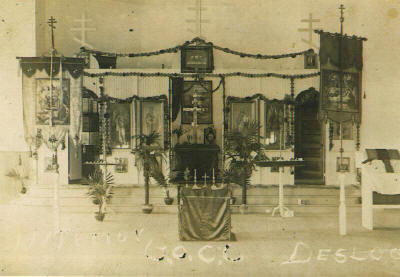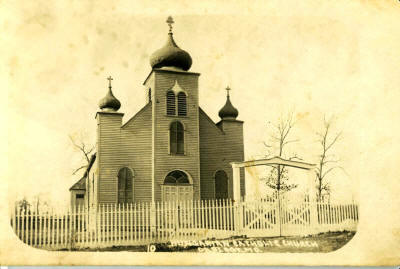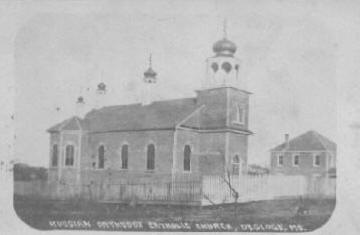RESEARCHER TELLS STORY OF AREA
RUSSIANS |
|
RESEARCHER TELLS STORY OF AREA
RUSSIANS |
|
(Editor's note: The following was written by Bro. Joe Welschmeyer who is doing research on the people from Russia and the Ukrain who settled in the Mineral Area. He hopes to hear from people who are related or have information on this group. He may be contacted by writing him at 7700 S. 43rd St., Omaha, Neb. 68147.)Around 1900 workers from Eastern Europe arrived in the Desloge area of St. Francois County, seeking employment in the lead and zinc mines of the region. Among these Slavic peoples were a group of immigrants from what is now known as the Ukrainian Soviet Socialist Republic, a republic of the Soviet Union. In 1986 these people would refer to themselves as Ukrainians. However, in 1900 there was no separate national designation for these peoples and they were classified as Russians, or Little Russians. The research so far shows that both Russians and Ukrainians were known to have been among the immigrants at Desloge. As there is nothing written on these people in local history, one is left with no choice except to start at their descendants and hope to gather some information. What is known is that around 1887, Piotr Pvokos from the Ukraine settled at the mining community of Desloge. By 1903 he was joined with others including families. Some thirteen of these families had come from "Drohobyycz" County of the Western Ukraine. This was an area that was controlled by the Austro-Hungarian Empire in Vienna, Austria. Inhabitants of the Western Ukraine were allowed by their government to emigrate to the Americas. However, those inhabitants of the Eastern Ukraine were under the Czarzist government in St. Petersburg, Russia, and these were not permitted to emigrate to America. These Ukrainians from the Western Ukraine who settled in St. Francois County had been recruited at some point to come to Southeastern Missouri to work in the mines. These first immigrants organized a Brotherhood which was a society or benevolent organization to care for the immigrants temporal and spiritual needs. Through this Brotherhood, a movement was started in 1905 to organize a Greek-Catholic (Ruthenian-Rite) parish. |
 |
| The Greek-Catholic priest from St. Louis, Mo., Rev. Joseph Czaplinsky, visited the community and in the summer of 1905 a mission parish was established. As there were no Greek-Catholic Diocese in America at the time, jurisdiction of the church was under the Roman Catholic Archbishop of St. Louis, Mo., Most Rev. John Glennon. The land for the parish was donated by the St. Louis Smelting and Refining Company. The patronage of the new parish would be "St. Mary's Assumption" (in traditional manner it would be "Dormition of the Holy Virgin Mary.") |
 |
The membership of some 500 persons included many from the Austro-Hungarian Province of "Galacia." There were also Hungarians and Carpatho-Rusyns who were from the south of the Carpathian Mountains. It would appear that some of the members of the church were members of the Eastern Orthodox Church who attended the Greek-Catholic parish because they had no church of their own. As the Greek-Catholics used Old Church Slavonic (not Latin as the Roman Catholics did) the Orthodox felt comfortable worshipping there. Several Greek-Catholic priests ministered to the parish before the Vatican authorities named Bishop Stephan Ortynski in 1907. In March 1908 a division occurred at the Desloge parish. Some of the members declared that they were not Catholic, but were Eastern Orthodox. They were among the trustees of the parish who voted not to recognize the Roman Catholic archbishop of St. Louis, nor the Greek-Catholic bishop of Philadelphia, Pa., but rather the Russian Orthodox Archbishop Platon of New York City. The result of this division of parishioners was an injunction issued by Judge Killian of Perryville, giving the Catholics possession of the parish. When an Orthodox priest, Fr. John Gratzon, took control of the rectory and the church vessels and vestments, the Archbishop of the St. Louis Archdioces brought the case to civil court for the return of the properties. The case was known as Glennon et al vs. Gratzon et al. The case was decided in favor of the Archbishop of St. Louis. The result of the court case was the building of a separate Orthodox parish church. This brick building stood on Tyler St. facing the city park and was built in 1910. This church was under the patronage of "Nativity of the Holy Virgin Mary" (went by other names at times). As this parish was under the jurisdiction of the Russian Orthodox Archbishop, its parishioners became designated as being "Russians." Before the court case the original parish had 500 members; afterwards some 266 individuals identified themselves as being Orthodox. After the court case the original Greek-Catholic church burned. This building stood on Monroe St. aside the railroad, it was replaced with a brick church near Walnut and Third St., north of the city park. It was built prior to 1914, but was not dedicated until 1924. (There is an incident with the bell having been stolen from the first church, and at least one source believed the church had been burned by arson). On July 13, 1917 mob action incited what became known as the "Lead Belt Mining Riot of 1917." The mob treatment of foreign workers forced these people to leave the area. Some returned only after the Missouri National Guard restored order to the area communities. The majority chose to find homes and employment in areas such as south St. Louis and in Detroit, Michigan. Those Russian and Ukrainians who remained in the area faced another crisis after the depression years. In 1933 several of the lead mines were closed, thus again reducing the membership of both the Greek-Catholic and Russian Orthodox parishes. Rev. Michael Lukasky was the pastor during its last years of the Greek-Catholic (Ukrainian) parish. From an original 500 members in 1905 the membership had continually declined. In 1925 the parish instruction class enrolled some 57 students. There was a lodge hall with a stage where plays were given in the Ukrainian language. By 1941 membership had dwindled and the hall was torn down. In 1944 the roof of the brick church was damaged by a tornado. Fr. Lukasky and his family lived in the rectory where he maintained a small chapel, for in his older years it was difficult for him to lead the Divine Liturgy in the church itself. He died on September 1, 1947 and was buried in the Immaculate Conception Catholic Cemetery in Flat River. At that time the church was closed. On May 21, 1957 the brick church was destroyed by a tornado. The membership of the Russian Orthodox parish dwindled too through the years. Since 1932 it has been served by the Russian Orthodox priest in St. Louis, Mo. On September 23, 1973 the parish celebrated its 65th anniversary while Rt. Rev. John Tertichny was mission pastor. On June 24, 1979, Bishop Boris of Chicago made his archpastoral visit to the parish as diocesan bishop. The membership of 47 (some not local) are served on occasion by a priest from the St. Louis Deanery of the Orthodox Church in America. (Since 1970 the title of the jurisdiction was renamed the Orthodox Church in America when it was granted self-government by the Patriarch of Moscow). Published in THE DAILY JOURNAL, Flat River, St. Francois Co. MO,
|
GREEK PRIEST [Note: I believe the newspaper misspelled quite a few of the names in this article. The names in brackets were added by me as possible alternative spellings.] Rev. Michael Lukasky, who has served as pastor of St. Mary's Greek Catholic Church in Desloge for eighteen years, celebrated his Golden Jubilee on Monday, September 2. The parish members served a dinner in honor of the occasion and a ball was enjoyed that evening at St. Mary's Hall. Rev. Lukasky was reared and educated in Europe, having attended high school at Lvov and the Universities of Theology in Rome, Vienna and Lvov. In the year 1885, he was ordained to the priesthood, at the age of 24 years and is now 74. Visitors from St. Louis who attended the celebration were: Mrs. Alex Gromocky and children, John, Pete, Victor and Ann, Mrs. Wm. Paraschok and daughters, Katherine and Stasha, Mrs. Nick Sopko and son, Joe, Mrs. Pete Lesh and children, Harry, John, Willie and Tessie, Mrs. John Tukianckich, Miss Anna Bacon [Bakan], Mr. and Mrs. Mike Andybur and daughter, Dorthy, John Matalich and daughter, Anna, Mr. and Mrs. George Evanko and children, Mary, John, Helen and George, Jr., Mike Kulczycki, Charles Nishki, Pete Kochmanski, Frank Kondrich, Wasyl Saraka and John Tyndyk. Members of the parish present were: Mr. and Mrs. Andrew Kolmar [Komar] , Mr. and Mrs. Pete Pesternak and family, Mr. and Mrs. Frank Kondrod and family, Mr. and Mrs. Pete Misturak and family, Mr. and Mrs. Frank Kolmar and family, Mr. and Mrs. Mike Kopach and family, Mr. and Mrs. John Tyndyk [Tyrpak] and family, Mr. and Mrs. Joe Benton, Mr. and Mrs. John Korobi and family, Mr. and Mrs. Mike Evanko and family, Nick Marcenasen, Mr. and Mrs. Joe Gresko and family. Others attending during the day and evening included: Mr. and Mrs. Andrew Bulno, Mr. and Mrs. Martin Hunady and son, John, Andrew Cmar, Mike Florian, Andrew Fedorco, John Temko [Timko] and son, Frank, Mr. and Mrs. Mike Yancek, Steve Ivanecke, Andrew Jusko [Jurko], Mike Muha [Mucho], John Vargo, Andrew Ancy and daughter, Mary, Harry Fedorco, Mike Pelok [Pelak], Mike Zieba, Sam Sagon [Sagan] and Mr. and Mrs. George Cash of Bonne Terre; Harry Market, Wasyl Dibroski, Paul Jinkerson, Tom White, Goff Qualls, Wilmer Laws, Mr. and Harold Koen, Miss Nell Pierce, Oliver Hulsey, Miss Mary Steck, Miss Tillie Steck, Miss Olga Steck, Miss Annie Dobrovasky and Miss Anna Dohoda of Desloge. |
REV. M. LUKASKY DIED IN DESLOGE Rev. Michael Lukasky, who had served as pastor of the Greek Catholic Church in Desloge the past twenty-five years, passed away at his home there on Monday, September 1, 1947, ending a lingering illness. He was 87 years of age. Rev. Lukasky, who was of Ukranian ancestry, was born in a small province in Europe, as was his wife, Mary Stelmaschuk Lukasky. They came to America about forty years ago. He had several brothers and sisters, but the family had not heard from them since the recent World War. He is survived by his wife and one daughter (Sophia) Mrs. James L. Blunt, Jr., and two grandchildren, Nancy Sue and Mark Noel Blunt of Desloge. Funeral services will be held this morning at 8:30 o'clock, at the church he served so long, and will be conducted by the Rev. Denyo of St. Louis. Interment will be in the Roman Catholic Cemetery, with Boyer Service. Published by THE LEAD BELT NEWS, Flat River, St. Francois Co. MO, Fri. Sept. 5, 1947. |
THE NATIVITY OF THE |
 |
| The Nativity of the Virgin Mary Orthodox Church, is located at The Church is adjacent to the very attractive THE LITTLE CHURCH BY THE TENNIS COURTS
By D.HICKMAN - Daily Journal Staff Writer DESLOGE - When Nancy Steck rises to read the liturgy for worship at
her church this morning and every Sunday morning, she remembers little girls in pretty
pink dresses. Decades ago, she was one of them.
|
The information on this site is provided free for the purpose of researching your genealogy. This material may be freely used by non-commercial entities, for your own research. The information contained in this site may not be copied to any other site without written "snail-mail" permission. If you wish to have a copy of a donor's material, you must have their permission. All information found on these pages is under copyright of Oklahoma Cemeteries. This is to protect any and all information donated. The original submitter or source of the information will retain their copyright. Unless otherwise stated, any donated material is given to MOGenWeb to make it available online.